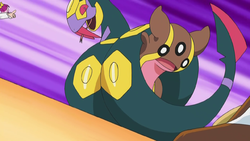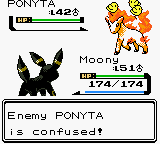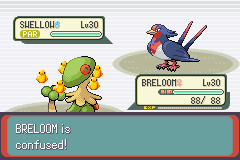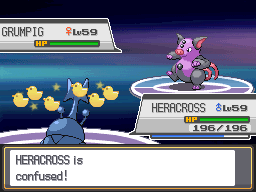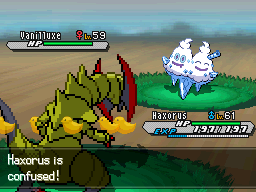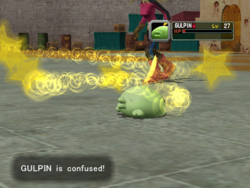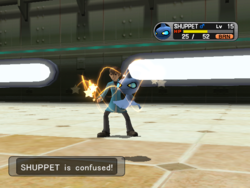Status condition
Status conditions (Japanese: 状態異常 abnormal condition), also referred to as status problems or status ailments, affect a Pokémon's ability to battle. There are three kinds of status. The first are non-volatile, the second are volatile, and the third lasts while a Pokémon is in battle. The Pokérus is a similar but unrelated concept.
Non-volatile status
A non-volatile status condition is a status condition that remains outside of battle and after being switched out. A Pokémon can only be afflicted by one non-volatile status condition at a time. They can be cured by healing at a Pokémon Center, specific curative items, and other ways. If a Pokémon is affected by a non-volatile status condition, an icon will display the type of status condition (replacing the Pokémon's level in Generations I and II).
In Pokémon Conquest all status conditions disappear after battle. Furthermore, a non-volatile status condition can be replaced with another non-volatile status condition.
Burn

- Main article: Burn (status condition)
The burn condition (BRN) inflicts damage every turn and halves damage dealt by a Pokémon's physical moves (except Pokémon with the Guts Ability). In Generation I and Generation VII, burn inflicts damage equal to 1/16 of its maximum HP every turn; from Generation II to VI, burn inflicts damage equal to 1/8 of its maximum HP every turn. Burn damage is halved if the Pokémon has the Ability Heatproof. In Generation V, Pokémon glow red while afflicted with burn.
Most moves which cause burn are Fire-type. In Generations I and II, Fire-type Pokémon cannot be burned by Fire-type moves (but they can be poisoned by Tri Attack in Generation II). From Generation III onward, Fire-type Pokémon and Pokémon with the Water Veil or Water Bubble Ability cannot normally be burned.
Freeze

- Main article: Freeze (status condition)
The freeze condition (FRZ) causes a Pokémon to be unable to use moves. A frozen Pokémon can still use the moves Fusion Flare, Flame Wheel, Sacred Fire, Flare Blitz, Scald, and Steam Eruption while frozen; these moves will thaw the user and be executed normally. In Generation V, Pokémon glow blue and stop moving while afflicted with freeze.
If a frozen Pokémon is hit by a damaging Fire-type move, Scald (Generation VI onward) or Steam Eruption, it will be thawed. From Generation II onward, the frozen Pokémon has a 20% chance to be thawed each turn, possibly even thawing right after being frozen; however, in Generation I, a frozen Pokémon never thaws without external aid. Pokémon cannot be frozen in harsh sunlight.
All moves which cause freezing are Ice-type, except Tri Attack (Generation II onward) and Secret Power (when used in snow or ice; Generation IV onward). In Generations I and II, Ice-type Pokémon cannot be frozen by Ice-type moves (but they can be frozen by Tri Attack in Generation II). From Generation III onward, Ice-type Pokémon and Pokémon with the Magma Armor Ability cannot normally be frozen.
Paralysis

- Main article: Paralysis (status condition)
The paralysis condition (PAR) reduces the Pokémon's Speed stat and causes it to have a 25% chance of being unable to use a move ("fully paralyzed") when trying to use one. From Generation I to VI, its Speed is reduced to 25% of its normal value; in Generation VII, its Speed is reduced to 50% of its normal value. Pokémon with the Quick Feet Ability instead have their Speed increased by 50% while paralyzed. In Generation V, Pokémon glow yellow while afflicted with paralysis and their animation will be slowed significantly.
Many moves that cause paralysis are Electric-type moves. In Generation I, Pokémon cannot be paralyzed by damaging moves of the same type as themselves. From Generation VI onward, Electric-type Pokémon cannot be paralyzed. Pokémon with the Limber Ability cannot normally be paralyzed.
Poison

- Main article: Poison (status condition)
The poison condition (PSN) inflicts damage every turn. In Generation I, poison inflicts damage equal to 1/16 of its maximum HP every turn; from Generation II onward, it inflicts damage equal to 1/8 of its maximum HP. A Pokémon with the Poison Heal Ability will restore an equivalent amount of HP instead of taking damage. In Generation V, Pokémon glow purple while afflicted with poison.
All moves which cause poison are Poison-type, except Twineedle, Secret Power (when used in tall grass; Generation III only), Psycho Shift (while poisoned), and Fling (if Poison Barb or Toxic Orb is held). Poison-type Pokémon cannot be normally poisoned. In Generation II, Steel-type Pokémon cannot be poisoned by Poison-type moves (but they can be poisoned by Twineedle); from Generation III onward, Steel-type Pokémon and Pokémon with the Immunity Ability cannot normally be poisoned. Poison- and Steel-type Pokémon can be poisoned by a Pokémon with the Corrosion Ability.
From Generation I to IV, a poisoned Pokémon loses 1 HP for every four steps taken outside of battle. In Generation IV, a Pokémon whose HP is reduced to 1 via poison outside of battle will have the poison status removed; in Generations I to III, its HP will be reduced to 0 (causing it to faint).
Badly poisoned
The bad poison condition inflicts damage every turn, with the amount of damage increasing each turn. It initially inflicts damage equal to 1/16 of the Pokémon's maximum HP, with the damage inflicted increasing by 1/16 each turn (2/16 on the second turn, 3/16 on the third turn, etc.). In Generation V, Pokémon glow purple while afflicted with bad poison.
In Generations I and II, if a badly poisoned Pokémon is switched out, the condition reverts to regular poison. From Generation III onward, the poison remains bad poison while switched out, but the damage counter will be reset when switched back in (i.e. it always will take 1/16 of its maximum HP as damage after switching in). After a battle is over, the badly poisoned status will become a regular poison.
All moves which badly poison are Poison-type, except Psycho Shift (while badly poisoned) and Fling (if Toxic Orb is held).
Sleep

- Main article: Sleep (status condition)
The sleep condition (SLP) causes a Pokémon to be unable to use moves, except Snore and Sleep Talk. From Generation V onward, Pokémon close their eyes while sleeping and move more slowly.
Sleep lasts for a randomly chosen duration of 1 to 7 turns in the handheld Generation I games, 1 to 3 turns in Pokémon Stadium and Generation V onwards,[1] and 1 to 5 turns in Generations II to IV (except the Japanese versions of Pokémon Diamond and Pearl). In the Japanese versions of Diamond and Pearl, the minimum and maximum sleep count is 1 turn higher, lasting 2 to 6 turns.[2] If a Pokémon puts itself to sleep using Rest, it will sleep for exactly 2 turns.
In addition to moves that cause sleep, a disobedient Pokémon may also nap during battle. Pokémon with the Vital Spirit or Insomnia Ability cannot normally be put to sleep.
In Generation I, a Pokémon that wakes up is not able to attack during that same turn; from Generation II onward, a Pokémon can wake up and use a move during the same turn. In Generation V only, a Pokémon's sleep counter is reset to its original amount when switched out; this also applies for self-induced sleep.
Volatile status
A volatile status is a status condition that is inflicted by a move or ability from another Pokémon and will wear off when a Pokémon is switched out of battle or when a battle is over. Many volatile status conditions will also wear off after a number of turns have passed. A Pokémon can be affected by multiple volatile status conditions at a time. A volatile status condition is not indicated by an icon.
Bound
When a Pokémon is hit by a binding move (Magma Storm, Sand Tomb, Whirlpool, Wrap, Bind, Clamp, Infestation, or Fire Spin), it becomes bound. Prior to Generation V, this lasts 2-5 turns (5 turns if the user of the binding move held a Grip Claw); from Generation V onward, the bound status lasts 4-5 turns (7 turns if the user of the binding move held a Grip Claw). A Pokémon can be only be bound by one binding move at a time. If a Binding Band is held by the user of the binding move, the damage done at the end of each turn will increase from 1/16 of the target's maximum HP to 1/8.
In Generation VI, the bound status deals 1/8 of the afflicted Pokémon's maximum HP at the end of each turn. In addition, holding a Binding Band increases this damage to 1/6 of the target's maximum HP. Furthermore, Ghost-type Pokémon are now immune to the trapping effect of these moves.
Generation I
In Generation I, binding moves inflict damage for 2-5 turns. There is a 37.5% chance that the move will last 2 turns, a 37.5% chance that it will last 3 turns, a 12.5% chance that it will last 4 turns, and a 12.5% chance that it will last 5 turns. Although only the first attack can be a critical hit, every attack during the duration will do the same amount of damage. While a Pokémon is bound, it cannot use moves, including on the turn it is hit if it would move second.
Damage done by a binding move's continuing duration is done after recurrent damage. If the user of the binding move switches out before the target is released, the target will be unable to attack during that turn. If the target switches out before the turn duration ends, binding move will automatically be used against the incoming Pokémon, deducting an additional PP from the move. If at such a time the binding move has 0 PP, it will still be used against the incoming Pokémon; in this case, due to a glitch, the move's PP will roll over to 63 and full PP Ups will be applied to it.
Even if the binding move misses, the target will not need to recharge for Hyper Beam. Additionally, if the user of the binding move attacks before the user of Hyper Beam during a recharge turn and the use of the binding move misses, the user of Hyper Beam will automatically use Hyper Beam during that turn. If at such a time Hyper Beam has 0 PP, it will still be used; in this case, due to the same glitch, the move's PP will roll over to 63 and full PP Ups will be applied to it.
In-game, the target will get to select a move during each turn of the binding move's duration, and will attack the incoming Pokémon with the selected move if the player switches before the duration is over.
In Pokémon Stadium, it is possible to select a move during each turn of the binding move's duration. If the target switches out before the duration ends, the incoming Pokémon will not automatically be attacked. A binding move will negate the recharge turn of Hyper Beam only if successful.
Generation II-IV
The target is now able to attack during a binding move's duration, and can act normally. Instead, the afflicted Pokémon takes damage equal to 1/16 of its maximum HP for 2-5 turns, in addition to the damage dealt when it is used. A bound Pokémon is also trapped, preventing it from switching and escape. A bound Pokémon can still flee (but not switch out) if it has the Ability Run Away or is holding a Smoke Ball. A bound Pokémon can still switch out (but not flee) if it is holding a Shed Shell.
If the user of the binding move is holding a Grip Claw, the duration will always be 5 turns.
If the user of the binding move switches out, all targets bound by that Pokémon's moves will be freed. If a bound Pokémon uses Rapid Spin, it will be freed.
Generation V
All binding moves now last 4-5 turns unless a Grip Claw is held, which causes the moves to last 7 turns.
If the user of the binding move held a Binding Band, the bound Pokémon takes 1/8 of its maximum HP as damage each turn (instead of 1/16).
Generation VI
A bound Pokémon now takes damage equal to 1/8 of its maximum HP each turn, instead of 1/16; if the user of the binding move held a Binding Band, the bound Pokémon takes damage equal to 1/6 of its maximum HP instead.
Ghost-type Pokémon can no longer be trapped, meaning that they can switch out and flee regardless of being bound. They are still afflicted by all other effects of being bound as normal, however.
Can't escape

A Pokémon that can't escape is unable to switch out or flee as long as the Pokémon that trapped it is on the field. The moves Mean Look, Spider Web, Block, Shadow Hold, Spirit Shackle, and Anchor Shot can inflict the can't escape condition.
A Pokémon that can't escape can still switch out if it is holding a Shed Shell; uses U-turn, Volt Switch, or Baton Pass; or is hit by Whirlwind, Roar, Dragon Tail, or Circle Throw. Prior to Generation V, if a Pokémon that can't escape uses Baton Pass, the Pokémon brought out will be trapped instead; from Generation V onward, the effect disappears.
Starting in Generation VI, Ghost-type Pokémon can switch out and flee regardless of the can't escape status.
Fairy Lock is a similar move that instead traps all Pokémon on the field during the next turn, instead of inflicting the can't escape status.
Confusion
- See also: List of moves that confuse
The confused condition causes a Pokémon to sometimes hurt itself in its confusion instead of executing a selected move. From Generation I to VI, the chance to hurt itself is 50%; in Generation VII, it is 33%. The damage is done as if the Pokémon attacked itself with a 40-power typeless physical attack (without the possibility of a critical hit).
Confusion wears off after 1-4 attacking turns. This means that turns recharging, such as after using Hyper Beam, and turns unable to attack, such as from paralysis, will not lower the remaining number of turns of confusion. However, a sleeping Pokémon may hurt itself in confusion if using a move such as Snore or Sleep Talk. Multi-turn attacks such as Fly and Dive require confusion to be checked both turns, further reducing the chance of a successful attack.
Pokémon with the Own Tempo Ability are immune to being confused. Confusion can be cured with Persim Berries, Touga Berries, the Yellow Flute, and, Generation II onwards, items that cure all status conditions such as Full Heals and Lum Berries; it is the only volatile status condition to be able to be cured by items that heal all status conditions.
Confusion is transferred by Baton Pass.
Focus Sash, Focus Band, and Sturdy can prevent a Pokémon from knocking itself out due to confusion.
A Ninja Boy on Route 211 erroneously states that confusion only wears off if the Pokémon is switched out.
In Pokémon Conquest, a confused Pokémon may move randomly, and if so, prevents the Pokémon from attacking, the Warrior using an item or activating a Warrior Skill. Confusion may wear off in the first turn.
In the anime, the depiction and symptoms of confusion has varied over the course of the show's long run:
- In the original series of the anime, Pokémon showed no physical difference when confused. They would often get dizzy and miss their attacks as opposed to attacking themselves.
- In the Advanced Generation series, Pokémon would get purple circles around their eyes as a sign of confusion and begin hurting themselves, or attacking their partner if in a Double Battle.
- In the Diamond & Pearl series, Pokémon's eyes become swirls and a circle of Torchic run around the confused Pokémon's head, with the confusion causing its attacks to miss.
- In the Best Wishes series, a Pokémon's eyes become stars and multiple stars spin around their head when they are confused.
- In the XY series, the Pokémon's eyes become sunken or glassy, and it will begin thrashing around, attacking itself or its allies in Double Battles.
Appearance in the games

|
This section is incomplete. Please feel free to edit this section to add missing information and complete it. Reason: Generation VI appearance |
Curse
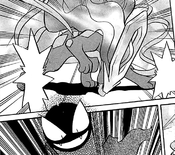
If a Ghost-type Pokémon uses Curse, the Pokémon it is used on loses ¼ of its maximum hit points every turn, and the user immediately loses half of their maximum hit points in exchange. A Pokémon afflicted by Curse cannot be healed except by switching out. If the victim of a Ghost-type Curse uses Baton Pass, the health-sapping effect is transferred to its replacement. Also, in Generation II, defeating the opponent will prevent the Pokémon it is used on taking damage from Curse on that turn.
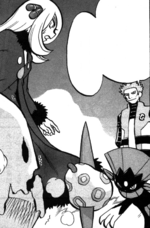
Embargo
A Pokémon under the effect of Embargo is unable to use its held item and its Trainer cannot use items on it (including Wonder Launcher items) for five turns. A Pokémon under the effect of Embargo cannot use Fling.
Encore
Encore forces the Pokémon to repeat its last attack for 2-5 turns in Generation II, 4-8 turns in Generations III and IV, and 3 turns in Generation V and VI. In Generation V, if the Pokémon has Magic Coat active, the move will fail.
Flinch
- See also: List of moves that cause flinching

The flinch status is a one-turn status that prevents a Pokémon from attacking. A Pokémon can only flinch if its opponent attacks first. A Pokémon who is holding a King's Rock or Razor Fang has a 10% of causing a target to flinch when using certain moves; in Generation II and III, any move that deals damage but does not have a secondary effect; in Generation IV, one of several moves on a list exclusive to the two items; in Generation V and Generation VI, any move that deals damage and does not already have a chance to flinch. Pokémon with the Inner Focus Ability are also immune to this. Most moves that cause flinching are physical moves. Pokémon with Steadfast still flinch, but gain Speed each time they do so.
It is known as "cringing" in Pokémon Mystery Dungeon: Red Rescue Team, Blue Rescue Team, Explorers of Time, Explorers of Darkness and Explorers of Sky. It is known as "flinching" from Pokémon Mystery Dungeon: Gates to Infinity onward.
In Pokémon Conquest, a Pokémon that has flinched is unable to perform any actions (i.e. move around, use moves), along with its partner Warrior (i.e. use Warrior Skills, use items, link). Since battles in this game are turn-based, flinching does not require a first strike via an advantage in Speed or priority, unlike in the main series. The turn-based gameplay and the duration of flinching also makes consecutive flinching impairment impossible, unlike in the main series.
Heal Block

A Pokémon affected by Heal Block is prevented from healing for five turns. It cannot use Moonlight, Morning Sun, Roost, Recover, Heal Order, Rest, Soft-Boiled, Wish, Milk Drink, Slack Off, Synthesis, or Heal Pulse while it is under effect. It is unaffected by the healing effects of Wish, Ingrain, Aqua Ring, Leech Seed, and Heal Pulse.
In Generation IV and V, a Pokémon affected by Heal Block can use HP-draining moves and still inflict damage, but will not restore HP. In Generation VI, a Pokémon affected by Heal Block cannot use HP-draining moves, except Leech Seed.
Pokémon with the Ability Volt Absorb or Water Absorb will take damage, as opposed to healing, from Electric- or Water-type attacks respectively while Heal Block is in effect. A poisoned Pokémon with Poison Heal is neither healed nor damaged.
From Generation V onward, Leftovers and Shell Bell cannot heal Pokémon affected by Heal Block. In Generation VI, Black Sludge cannot heal Pokémon affected by Heal Block. Items such as Potions can still be used to heal the Pokémon.
Identified
The opponent's evasion modification will not affect the accuracy of a Pokémon that uses Foresight, Odor Sleuth, or Miracle Eye. In addition, a Normal- or Fighting-type move used by a Pokémon that has used Foresight or Odor Sleuth will affect Ghost-type Pokémon, and Psychic-type moves used by a Pokémon that has used Miracle Eye will affect Dark-type Pokémon.
Infatuation
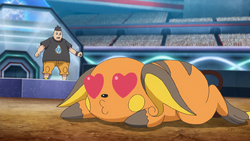
A Pokémon that is infatuated cannot attack 50% of the time, even against Pokémon other than the one it is infatuated with. It is caused when Attract is used on an opponent of the opposite gender, may be caused when a Pokémon makes contact with a Pokémon of the opposite gender that has Cute Charm as its Ability, and is caused to the target of the infatuation when a Pokémon holding a Destiny Knot is infatuated.
Pokémon with the Oblivious Ability are immune to infatuation. Infatuation cannot be passed with Baton Pass. Infatuation will end as soon as either the affected Pokémon or the Pokémon it is attracted to is removed from the battle. It can also be removed by consuming a Mental Herb or an Eggant Berry, or by playing a Red Flute.
In Pokémon Mystery Dungeon series, Infatuation prevents the Pokémon from doing anything for 5-6 turns, and causes linked moves to cease.
Leech Seed

The Leech Seed status can only be caused by Leech Seed. Each turn, a Pokémon afflicted with Leech Seed loses 1/8 (1/16 in Generation I) of its maximum hit points. The opponent is healed by the same amount. Grass-type Pokémon cannot be afflicted with Leech Seed.
If a Pokémon afflicted with Leech Seed uses Baton Pass, Leech Seed is transferred to its replacement, even if it is Grass-type. If the Pokémon that used Leech Seed switches out or faints, any Pokémon in the same position as the original user gains the drained HP instead.
Unlike in the games, Leech Seed does not appear to restore the health of the Pokémon that used the attack in the anime.
Nightmare
Nightmare only affects a sleeping Pokémon. The sleeping Pokémon loses ¼ of its maximum hit points every turn. If the sleeping Pokémon awakens, then the nightmare will no longer be in effect. If Baton Pass switches in a Pokémon that is not asleep (via Sleep Talk), then the nightmare will no longer be in effect.
Perish Song
After three turns, all Pokémon who heard the Perish Song will faint, excluding Pokémon with the Soundproof Ability. Any Pokémon who heard it can avoid the effect of fainting if it is switched out before the three-turn count finishes. Baton Pass transfers the Perish Song countdown.
Spooked
This status condition is inflicted by Pokémon with the Spookify Skill in Pokémon Shuffle. A spooked Pokémon takes 50% more damage from Ghost-type Pokémon.
Fighting, Poison, Ground, Rock, Bug, Steel, Grass, Ice, Dragon, and Dark-type Pokémon are immune to being spooked.
Taunt
A taunted Pokémon cannot use any status moves for 3 turns (2-4 turns prior to Generation V), including status moves that will always turn into damaging moves like Nature Power. The Taunt status can only be inflicted by the move Taunt.
From Generation V onward, the Mental Herb cures the Pokémon of Taunt. From Generation VI onward, Pokémon with Oblivious are immune to the Taunt condition; if a Pokémon with Oblivious is afflicted by Taunt (such as if it is taunted by a Pokémon with an Ability like Mold Breaker), it will be cured immediately. Pokémon with Aroma Veil and their allies are immune to Taunt.
Telekinesis
A Pokémon telekinetically levitated by Telekinesis is immune to Ground-type moves, Spikes, Toxic Spikes, and Arena Trap for three turns. In addition, all other moves, except one-hit knockout moves, hit the target regardless of accuracy and evasion; however, it does not allow moves to hit semi-invulnerable Pokémon.
The effect of Telekinesis is canceled when Gravity is used, the levitated Pokémon uses Ingrain, or the levitated Pokémon obtains an Iron Ball; Telekinesis cannot lift targets if Gravity is in effect, and will fail if used on a target that is rooted or holding an Iron Ball.
Torment
A tormented Pokémon cannot use the same move twice in a row. If the Pokémon is holding a choice item or only has one move remaining with PP, it is forced to use Struggle every second turn.
Volatile battle status

|
The contents of this section have been suggested to be split into Battle status. Please discuss it on the talk page for this section. |
A volatile battle status is usually self-inflicted and will wear off when a Pokémon is taken out of battle or a battle is over. Many of these will also wear off after a number of turns pass. Since they aren't shown in battle as a status condition (having an icon) a Pokémon can be affected with multiple volatile battle statuses, volatile conditions and a non-volatile condition at the same time.
Aqua Ring

When a Pokémon surrounds itself with a veil of water by using Aqua Ring, it restores 1/16th of its maximum HP every turn. This effect can be transferred by Baton Pass.
Bracing
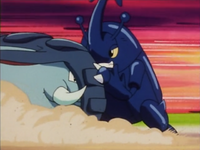
When a Pokémon uses Endure, it braces itself so that whenever it takes damage that turn it will always survive with at least 1HP. The Focus Sash, Focus Band, and Ability Sturdy all have similar effects.
Center of attention

A Pokémon can become the center of attention by using Follow Me or Rage Powder, or by being affected by Spotlight.
If a Pokémon is the center of attention, its opponents are forced to target the center of attention rather than their intended target for the rest of the turn, if it is a valid target for those moves (even if the move originally targeted an ally, unless it is a move that cannot target an opponent such as Acupressure or Helping Hand). If a move cannot target the center of attention, it will be used on its intended target. Even if a Pokémon becomes the center of attention, its allies will not be forced to target it.
If the center of attention faints, switches out, or is taken into the air by Sky Drop, it no longer draws moves.
In Triple Battles, the center of attention will draw the attacks of all opponents in the field, but it can only draw attacks from non-adjacent opponents if they use a move which is able to strike non-adjacent targets.
The center of attention cannot draw moves with a charging turn like Sky Drop or Solar Beam, even if they are executed in one turn due to Power Herb.
The center of attention draws Electric- and Water-type moves even if a Pokémon with Lightning Rod or Storm Drain is on the field. If another Pokémon on the same team is already the center of attention, the first user takes priority; if the first user is outside of range or stops being the center of attention, the attack will be drawn to the next center of attention.
From Generation VI onward, Grass-type Pokémon, Pokémon with Overcoat, and Pokémon holding Safety Goggles will not have their moves drawn to a Pokémon that becomes the center of attention due to Rage Powder.
Defense Curl
Using Defense Curl causes the power of Rollout and Ice Ball to double for the Pokémon. This effect is not transferred by Baton Pass.
Glowing
A Pokémon readying Sky Attack becomes cloaked in light for one turn, in which it cannot act. This turn can be skipped with a Power Herb.
Rooting

When a Pokémon plants its roots by using Ingrain, it restores 1/16th of its maximum HP every turn but cannot switch out or flee, even if hit by a move that would force this such as Roar and Dragon Tail. If a Flying-type Pokémon or a Pokémon with Levitate is rooted to the ground, it is susceptible to Ground-type moves, Spikes and Toxic Spikes. The Pokémon cannot be affected by Magnet Rise and Telekinesis and they are removed if active upon rooting. This effect can be transferred by Baton Pass.
Magic Coat

A Pokémon shrouded with Magic Coat will reflect most status moves used against it or its side of the field back at the user during the turn it used the move. The Ability Magic Bounce reflects the same moves.
Magnetic levitation

A Pokémon levitating on magnetism via Magnet Rise is immune to Ground-type attacks for five turns. Like Flying-type Pokémon and Pokémon with Levitate, the user is immune to the damage of Spikes and Toxic Spikes, and is unaffected by Arena Trap. Magnet Rise is completely negated by Gravity, Ingrain, and holding an Iron Ball.
This effect can be transferred by Baton Pass.
Minimize
A Pokémon that has used the move Minimize (or had the effect passed to it via Baton Pass) will be affected more harmfully by some moves.
From Generation II onward, Pokémon that have used Minimize will take double damage from Stomp. From Generation V onward, Pokémon that have used Minimize will also receive double damage from Steamroller. In Generation VI, Pokémon that have used Minimize will take double damage from Body Slam, Dragon Rush, Flying Press, and Phantom Force; also in Generation VI, all of these moves will always hit a target that has used Minimize.
Protection
A Pokémon that uses Protect, Detect, Spiky Shield, or Baneful Bunker will be unaffected by both damaging moves and status moves during that turn. A Pokémon that uses King's Shield will be unaffected by damaging moves for the rest of that turn.
If the protected Pokémon is hit by Feint, Shadow Force, Hyperspace Fury, Hyperspace Hole, or Phantom Force—which can all hit regardless of protection—the Pokémon's protection is removed for the rest of the turn.
Some moves cannot be stopped by protection, such as Future Sight and Curse.
Team protection
If a Pokémon uses Mat Block, Wide Guard, Quick Guard, or Crafty Shield, that Pokémon and its allies will be unaffected by particular moves for the rest of that turn.
- A Pokémon protected by Mat Block is unaffected by damaging moves.
- A Pokémon protected by Wide Guard is unaffected by moves that can target multiple Pokémon at once (such as Heat Wave and Earthquake).
- A Pokémon protected by Quick Guard is unaffected by increased priority moves.
- A Pokémon protected by Crafty Shield is unaffected by status moves.
If any protected Pokémon is hit by Feint, Shadow Force, Hyperspace Fury, Hyperspace Hole, or Phantom Force—which can all hit regardless of protection—the effects of all team protection moves will be lifted from that Pokémon and its allies.
Recharging
A Pokémon that successfully uses Hyper Beam, Frenzy Plant, Blast Burn, Hydro Cannon, Giga Impact, Rock Wrecker, or Roar of Time must recharge during the next turn. While recharging, the Pokémon cannot perform an action.
Semi-invulnerable
Several two-turn moves have a turn where a Pokémon becomes semi-invulnerable, and most moves will miss regardless of accuracy, even moves that never miss. If a Pokémon has been taken aim at, the aimed Pokémon can still hit Pokémon during their semi-invulnerable turn. A Pokémon with No Guard can hit the Pokémon during their semi-invulnerable state, and a Pokémon with No Guard in the semi-invulnerable state can be hit by any Pokémon. In Generation I, semi-invulnerable Pokémon cannot avoid Swift, Transform, or Bide, but can avoid Bide in Pokémon Stadium. With the exception of Sky Drop, the semi-invulnerable turn can be skipped with a Power Herb.
Pokémon that have used Fly, Bounce, or Sky Drop (both the user and target) fly up high. Pokémon that have flown up high are vulnerable to Gust, Smack Down, Sky Uppercut, Thunder, Twister, and Hurricane. If the move Gravity is used, Fly, Bounce, and Sky Drop cannot be used, and any Pokémon in the air return to the ground with their move cancelled; due to a glitch in the Generation V games, if Gravity is used while Sky Drop is in effect, only the user will be returned to the ground—the target will be permanently stuck airborne.
Pokémon that have used Dig burrow underground, and can be hit by Earthquake, Magnitude, and Fissure.
Pokémon that have used Dive dive underwater, and can be hit by Surf and Whirlpool.
Pokémon that have used Shadow Force or Phantom Force suddenly disappear, and there is no move that can hit these Pokémon without aiming or No Guard.
Substitute

The Pokémon that uses Substitute uses up to ¼ of its total HP (rounded down) to make a substitute which will absorb hits until it "breaks" (damage the substitute has taken is equal to or greater than the HP used to make it).
Substitutes also prevent the opponent from lowering the user's stat stages. From Generation II onward, substitutes block the opponent from inflicting all status conditions. In Generation I, a substitute will only block certain status conditions under certain circumstances, and attacks like Thunder Wave and Spore will completely circumvent the substitute.
Substitutes can be transferred by Baton Pass.
Taking aim

When a Pokémon uses Mind Reader or Lock-On to take aim at a target, the user's next damage-dealing move will hit that target without fail, even if the opponent uses a move that offers a turn of semi-invulnerability, such as Fly. This effect can be Baton Passed.
Taking in sunlight
A Pokémon readying Solar Beam takes in sunlight for one turn, in which it cannot act. This turn can be skipped with a Power Herb or if used in harsh sunlight.
Withdrawing
A Pokémon readying Skull Bash withdraws it head for one turn, in which it cannot act. From Generation II onwards, this also boosts the Pokémon's Defense. This turn can be skipped with a Power Herb.
Whipping up a whirlwind
A Pokémon readying Razor Wind whips up a whirlwind for one turn, in which it cannot act. This turn can be skipped with a Power Herb.
Trivia
- If a Pokémon under a status condition (such as a poisoned Cascoon) evolves, the condition will be kept even if the Pokémon gains a new type or Ability that would normally prevent it.
In other languages
|
Status
|
Status condition
|
Confused
| |||||||||||||||||||||||||||||||||||||||||||||||||||||||
References
| Status conditions | |||
|---|---|---|---|
| BURN | FREEZE | PARALYSIS | POISON |
| SLEEP | CONFUSION | FLINCH | FAINTING |

|
This game mechanic article is part of Project Games, a Bulbapedia project that aims to write comprehensive articles on the Pokémon games. |
